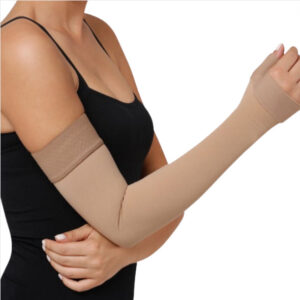What is lymphedema?
Lymphedema is a medical condition characterized by unusual swelling of a part of the body. Swelling is caused by an abnormal buildup of lymphatic fluid, commonly called lymph, in one part of the body. This condition occurs when the lymphatic system is impaired or damaged, preventing normal lymph drainage. People who have undergone surgery, radiotherapy, or other treatments for cancer, trauma or suffering from chronic venous insufficiency or morbid obesity are at risk.
Lymph circulates throughout the human body and carries white blood cells, antibodies, and nutrients. It is involved in the elimination of waste, maintaining the balance of bodily fluids, and immune defense. The more invasive the surgery or treatment, the greater the risk of developing lymphedema. Additionally, anyone who has had an armpit or groin procedure is at high risk.
Lymphedema cannot be cured. It is a chronic disease that can be controlled.
There are two types of lymphedema:
Primary lymphedema: which is already present at birth or appears later for unknown reasons. This type of lymphedema is rare.
Secondary lymphedema: which usually occurs in the years following cancer treatments, including surgery and radiotherapy, or as a result of venous insufficiency and morbid obesity.
Symptoms
The main symptom of lymphedema is swelling in the affected part of the body.
Other symptoms that may accompany this swelling include:
- feeling of heaviness or stiffness;
- pain;
- skin tightening;
- decreased flexibility or mobility of the affected body part;
- feeling that clothes or jewelry are too tight.

Treatment
Treatment of lymphedema aims to reduce swelling, improve lymphatic circulation, relieve symptoms, and helps prevent other complications. The medical staff will offer you the appropriate treatment depending on your state of health.
Treatments to reduce swelling
A certified lymphedema therapist will perform a conventional treatment called decongestive lymphatic therapy to reduce swelling. This specialist will offer you a treatment plan specific to your condition.
Lymphedema treatment is generally an ongoing process and requires regular monitoring to maintain the results obtained.
When the swelling is reduced to a minimum, it will be necessary to wear a compression garment during the day, and sometimes at night. This garment should be worn long term. It helps control swelling and prevent several complications. Compression garments should only be worn on the recommendation of a doctor. They must be adjusted by a specialist.
Reimbursement of bandages and compression garments
For more information, contact us at 438-929-3553 or visit our online store to see the different models offered.

Treatment includes:
- compression using multi-layer bandages or compression clothing;
- manual lymphatic drainage (MLD);
- skin care;
- gentle and specific exercises;
- prevent excessive compression;
- elevation of the affected body part;
- do not expose yourself to extreme temperatures;
- self-management of the skin to avoid infections;
- laser therapy.
If left untreated, lymphedema can:
- cause swelling of the affected body part;
- increase the risk of infection or sores;
- cause difficulty completing daily tasks;
- cause psychological distress.
When you have lymphedema, you can maintain your health by following these recommendations:
- watch for signs such as redness, swelling, irritation, itching or increased temperature in any part of your body;
- protect the skin of the affected part of the body to avoid the risk of infection. For example, wear gloves when gardening.

